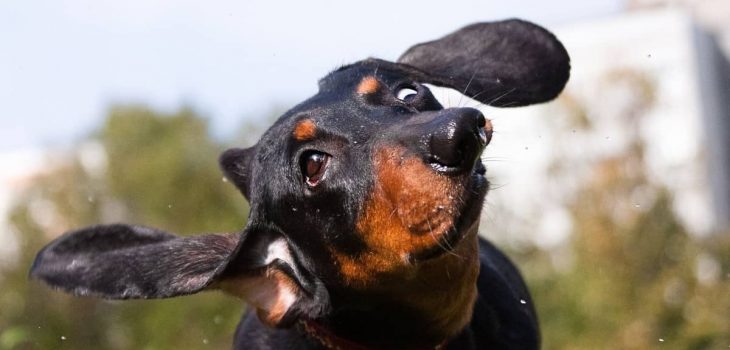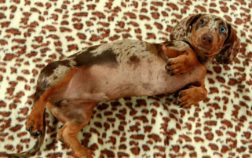Dog ears come in dozens of different shapes and sizes. Floppy ears, however, are our fan favorites! Here are 16 awesome floppy ear dog breeds. And, while we tend to just call them all “floppy”, they can actually vary quite a bit – long, wide, v-shaped, perky, and others. They are also often called pendant ears or lop ears but floppy is the most common term.
Floppy Ear Dog Breeds
While most people immediately think of bloodhounds, there are actually many dogs with floppy ears. Even breeds like the German Shepherds can have floppy ears but most breeders and dog owners “train” their ears to stand upright. There are also lots of small floppy ear dog breeds that we often don’t view as floppy cause they are not that large.
So, What Exactly Are Floppy Ears?
Any ear that’s hanging down either from its base or that starts hanging after going up for a bit is technically a “floppy ear”. In fact, “floppy” isn’t really a type of ear, it’s just a blank term for several different types. You can check our breakdown on the 12 different types of dog ears here.
So, when we talk about floppy or pendant ears what we actually mean are the folded, dropped, V-shaped rose, as well as cocked and button ear types. The rare Filbert-shaped ear type is also floppy.
If you want, you can view some of these types as not really floppy – that is partly subjective. Rose ears, for example, tend to go up and away from the dog’s head for quite a while before they start hanging down. So, maybe we can call them “semi-floppy”? Either way, they do hang down and are still adorable.
Why Even Are There Floppy Ear Dog Breeds?
If all dogs are descendants of wolves and wolves don’t have floppy ears, then why do some dog breeds have this feature? Wasn’t the point of dogs’ selective breeding to enhance certain characteristics? What’s so “enhanced” about long floppy ears that worsen the dog’s hearing?
There is a popular theory among dog owners and bloggers that the ears of most hound breeds are purposefully floppy. The idea is that breeders of bloodhounds, basset hounds, and other scenthound dogs bred them with floppy ears cause that’d help their sense of smell. If that sounds far-fetched, stick with us.
According to this theory, the large and floppy ears of such hound breeds are so long that they “trap” more air around the dog’s muzzle and nose. That, in turn, helps the dog detect even lighter and more delicate scents in the air.
And there is some truth to this – the long and floppy ears of bloodhounds, basset hounds, and other such breeds do trap more air around the dog’s muzzle. However, it’s not really clear whether that was an intentional effect sought after by these dogs’ breeders or whether it was a side-effect.
After all, not every evolutionary outcome (or outcome of selective breeding, in this case) is purposeful. There are countless examples in dogs, humans, and any other animal of evolutionary bi-products – characteristics that don’t really bring any evolutionary benefit but also aren’t too detrimental to hamper the animal’s development, survival, and procreation. For example, what’s the purpose of the bulldog’s tail pocket? There doesn’t seem to be any!
As far as we can tell, there’s no direct evidence that breeders purposefully bred hound breeds with floppy ears to help their sense of smell. Instead, it seems much more likely that they bred dogs for their nose and low body frame, and the floppy ears were just a bi-product. The fact that the bi-product has its own minorly helpful function seems to be a coincidence.
Besides, there are many non-scenthound breeds with floppy ears too. This seems more the result of simple gravity than any breeding mastermind.
Are There Any Drawbacks Of A Dog With Big Floppy Ears?
Yes and no. If you’re worried about your current or future pet’s health, floppy ears aren’t really detrimental in any significant way. The only “drawbacks” of these ears are the following two:
A long floppy ear does somewhat reduce the dog’s hearing. However, that’s not overly significant. Dogs have excellent hearing anyway so they are still able to hear us from any corner of the dog park when we call to them.
Floppy ears do make ear hygiene more important. If you have a floppy ear dog you should pay extra care inspecting and cleaning its ear to avoid infection. However, you should still do this for dogs with perky ears – it’s just easier to notice the dirt there. So, as long as you inspect and clean your dog’s ears regularly, there should be no problem regardless of the ears’ shape.
Dogs With Long Floppy Ears
Now that we understand the why and how of dogs’ floppy ears, let’s go over some of our favorite floppy-ear dogs. What people usually imagine when they hear of dogs with floppy ears are the various scenthound breeds there. And these are indeed impressive – it’s not actually rare to see a Basset hound with ears longer than its legs! Here are a few of our favorite long-eared dog breeds:
- Basset hound

- Black and tan coonhound
- Bloodhound
- Afghan hound
- Bluetick coonhound
- Poodle
- English Cocker Spaniel
Dogs With Short(-ish) Floppy Ears
Aside from the traditional hound breeds, there are a lot of other breeds with shorter but still floppy ears. Many of them, like the dachshund or the Beagle, are scenthounds too but their ears aren’t nearly as long as that of a bloodhound.
Others, like the setter or retriever breeds, aren’t scenthounds at all. And, while shorter, their ears are categorically floppy. Here are a few awesome short floppy ear dog breeds to consider:
- Dachshund
- Beagle
- Setter
- Labrador Retriever
- Golden Retriever
- Saint Bernard
- Havanese
- Bedlington terrier
- Japanese chin
Long or short, v-shaped or wide, rose or cocked, floppy ears are all beautiful! Some dog owners dislike them and try to train certain breeds’ ears to stand straight up but, for us, few things are cuter than the velvety floppy ear of a dachshund or a lab.




